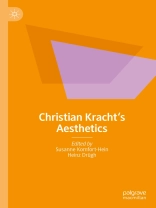The contributions to this volume are devoted to Christian Kracht’s aesthetics under two main aspects: On the one hand, with regard to sometimes irritatingly twisted actualizations of that self-reference and reservation which, since Kant, is to be evaluated as a central mode of the aesthetic; on the other hand, with regard to interferences with areas that are usually perceived as extra-aesthetic, but which can be evaluated as ferments of contemporary aesthetics: Stagings in the field of the literary establishment, the aesthetic under media and market conditions, and in the focus of canonization and criticism. Kracht’s Frankfurt Poetics Lectures, which were intensively commented on by the media, form the background to this discussion.
Inhaltsverzeichnis
1. introduction.- 2. part I. Microaesthetics.- 3. Christian Kracht’s microaesthetics.- 4. DJ Bobo in Ulan Bataar. A way out of the whole in Christian Kracht’s aesthetics?.- 5. ‚… a continuing always repeated disturbance‘. Christian Kracht with Max Bense and Friedrich Schlegel -Response to the contributions of Christoph Kleinschmidt and Maria Kuberg.-6. Part II. Aesthetics of the literary world.- 7. Aesthetics of paratexts in Christian Kracht. Quotations, cover designs, author figures.- 8. ‚In Search of a Character‘. Christian Kracht’s self-staging practices in the authorial photograph.- 9. The image given and the image taken – Responding to the contributions by Christine Riniker and Ronald Röttel.- 10. Part III. Aisthesis – Body and Mind.- 11. Surface aesthetics. The Barbour jacket as a second skin in Christian Kracht’s novel Faserland.- 12. ‚Nothing is meaningless.‘ On the Relationship between Spirituality and Postmodernism in the Novels of Christian Kracht.- 13. No Stable Position in Sight – Responding to the Contributions of Julia Bertschik and Robert Hermann.- 14. Part IV. Aesthetic Mode and Historical Truth.- 15. Mediologies of the Counterfactual in Christian Kracht’s I Will Be Here in Sunshine and in Shadow.- 16. Of Faded Photographs and Rattling Projectors. On the Anti-Documentary Aesthetic in Christian Krachts Imperium.- 17. Aesthetic Mode and Historical Truth – Responding to the Contributions of Caspar Battegay and Christoph Schmitz.- 18. Part V. Exploration of Alternative Aesthetics.- 19. Of all the novels, I do appreciate the most the interesting ones. Aesthetics of the reserved and poetics of the interesting in Christian Kracht’s Die Toten.- 20. ‚In Praise of the Shadow‘. Christian Kracht’s The Dead as a ‚Japanese Aesthetic‘.- 21. ‚[T]he Scaffolding of the Letter H‘ – Responding to the Contributions of Marvin Baudisch and Azusa Takata.- 22. Part VI. Literary Aesthetics.- 23. ‚Barbourpapa‘. A source-philological investigation into the textual genesisof Faserland.- 24. Self-reference and its disorders. On a socio-political dimension of Christian Kracht’s poetics and his novel Imperium (2012).- 25. Literary aesthetics and the hermeneutics of the subject: subjectivation in Christian Kracht – Responding to the contributions of Philip Ajouri and Matthias N. Lorenz.- 26. Part VII. After the Poetics Lecture.- 27. Variations on an Unavailable Text. Christian Kracht’s Frankfurt Poetics Lectures.- 28. Ineffable. Hermeneutics, Poetics and Charlie Chaplin in Christian Kracht.- 29. Christian Kracht’s Postmodern Parodies.
Über den Autor
Susanne Komfort-Hein Professor of Modern German Literature at the Goethe University Frankfurt.Heinz Drügh is Professor of Literary History of the 18th and 19th Century / Aesthetics at the Goethe University Frankfurt.












